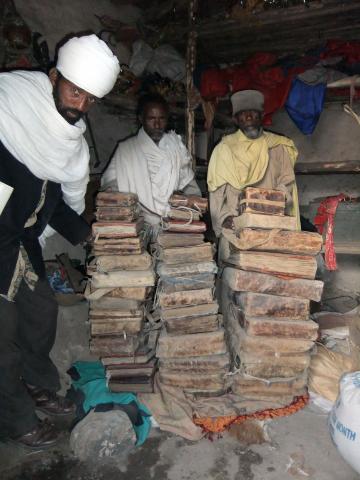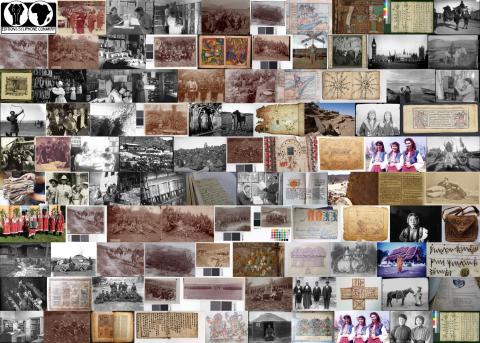
Aims and objectives
The national sound archives of the Union of Comoros consists of approximately 1,000 magnetic audio tapes, stored at the Comorian national research centre (CNDRS) in Moroni. The lack of climate control in the storeroom means that these tapes are deteriorating rapidly and a number of them already show signs of physical degradation. In addition to extremes of temperature and humidity, in 2005 there was a volcanic eruption on the island and ash deposits accumulated on the tapes causing some damage.
The collection is a unique record of Comorian cultural practice and social history; the core of the collection was constituted in the last quarter of the 20th century by the founding director of the CNDRS, Damir Ben Ali, and his successors who, recognising the very real threat of loss of oral records, implemented a project to collect as much material as possible. His team conducted interviews throughout the country on oral tradition, anthropological and historical topics, and collected recordings of cultural performances, including songs, poetry and music. Many of the recorded practices and performances have disappeared, both under the influences of what might be termed modernisation and as a result of social changes during the revolution of 1975-1978. Likewise, not only has much of the oral history has been lost as an older generation disappears and the younger generation turns to radio and television, but written primary sources that could have provided material for historiographies of the early colonial period were largely destroyed during the same revolution. A lack of academic interest in the Comoros in the colonial period (and particularly prior to the second world war) means that these oral histories constitute almost the entire corpus of extant primary material on pre- and early colonial Comorian history; they are an extremely valuable and irreplaceable source for research on cultural practice and historical change. Those recordings that have been used and analysed in the past have proved to be unique and valuable sources of data.
Equipment will be purchased to treat and digitise the tapes and store both the ensuing digital and the surviving original tape archive. Most of the equipment will be purchased or supplied by the Swiss National Sound Archives (SNSA), who will be acting as trainers and advisors to the project. Two experts from SNSA will travel to Moroni for a period of two weeks, where they will begin the digitising process. As they digitise they will be assisted by, and will train, two CNDRS sound archivists and local IT personnel.
The archive is now effectively closed to researchers and will undoubtedly remain closed until the material is digitised. Every tape will be examined, tested and the analog signal converted to digital and recorded on high resolution WAV files, according to IASA TC-04 guidelines. Those files will contain only what is extracted from a single tape or set of tapes, and they will be considered as the first generation “archive copy”.
The original archive may suffer damage during the digitisation process but every effort will be made to ensure the majority of the tapes will be preserved intact and they will subsequently be stored in a climate-controlled environment. The digital copies will be stored locally on hard disk in duplicate; one will feed the server and provide free local access to the files to scholars under the normal conditions of access to CNDRS archives while the second copy will serve as backup. A third copy will be transferred to the British Library. It is intended that the data will be accessible over the internet. Comorian bandwidth limitations currently make it unlikely that this archive will be hosted locally for international access, and it is expect that the catalogue and at least part of the online archive be hosted elsewhere. The equipment will remain with the CNDRS and will allow for the CNDRS to subsequently digitise the archives of Radio Comores at the end of the EAP project.
Visit the project's website here
Outcomes
The project achieved its aims and the entire sound archive was successfully digitised despite various problems of a technical and administrative character. The greatest problem facing the team was the chronic interruptions to the electricity supply, despite having purchased a voltage stabiliser. The problems continued throughout the project and eventually caused severe damage to the main fileserver, rendering it inaccessible for many months.
The archive team remains committed and a number of individuals have come forward with private collections that the CNDRS will store in exchange for being permitted to digitise and retain the sound files for public access. The tape storage room and the sound archive room are now air-conditioned and (electricity permitting) the storage conditions of both original and digital archives are secure.
The original magnetic tapes are now stored in an air-conditioned room at the CNDRS and are accessible if necessary. Contrary to expectations, surprisingly little damage occurred to the tapes during the digitisation process. The digital files are now accessible in the CNDRS computer room through a dedicated terminal and it is intended that they will be made more widely accessible in the centre.
The initial training session by the technical team from Phonoteca was attended by a number of individuals, including the core CNDRS staff. All received full training where appropriate in the use both of the audio equipment and of the software.
The project manager, Yakina Mohamed Djelane, and the head of the audiovisual section of the national archives, Ahmed Aboubakar, oversaw the implementation project and brought it to a successful conclusion. Special mention should be made of sound archivists Fatouma Aboudou and Hachimia Mohamed Bakri, who were responsible for the bulk of the digitisation over the two years of the project and carried out this task under often difficult conditions.
The project has contributed to the development and the reputation of the CNDRS as an archival centre, placing valuable cultural heritage at the disposition of both researchers and the wider community.




